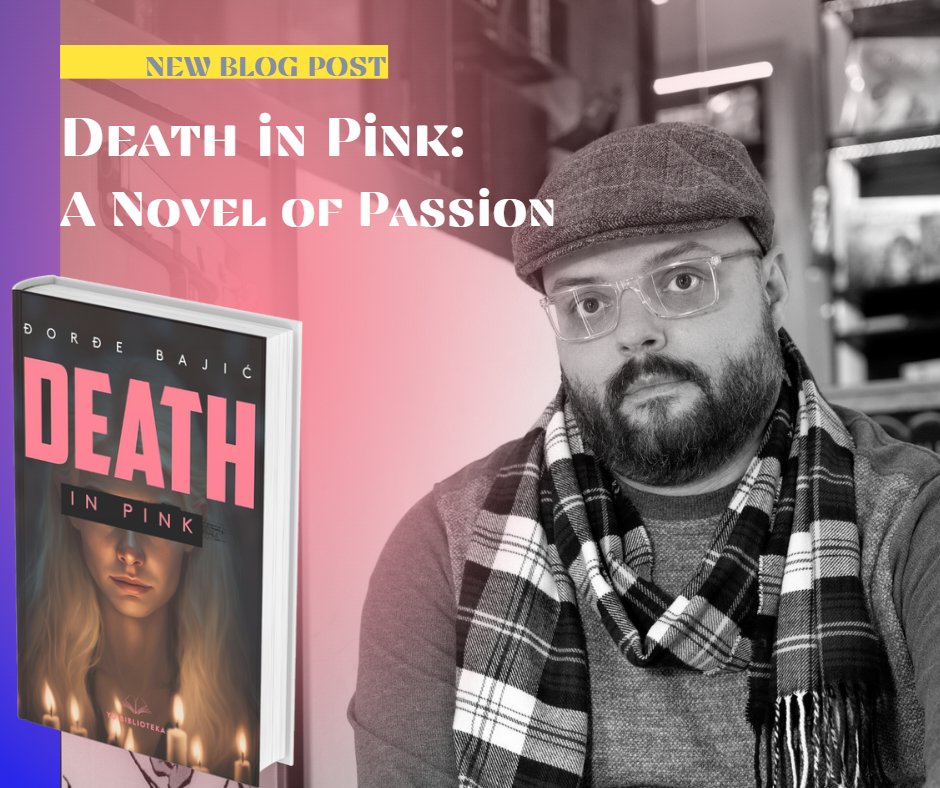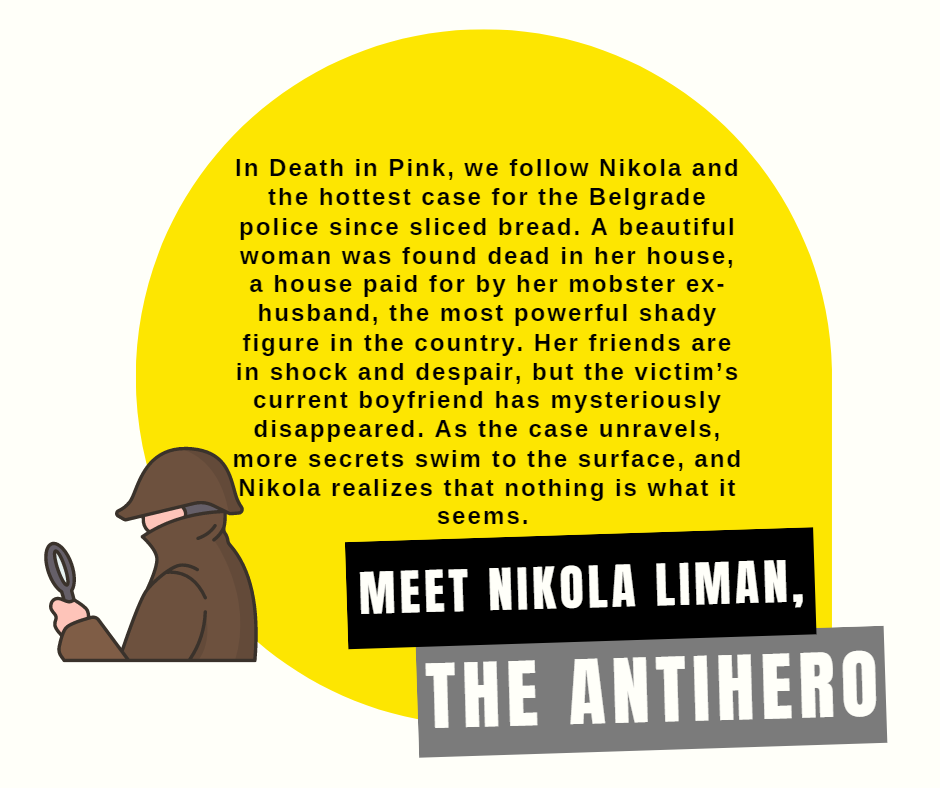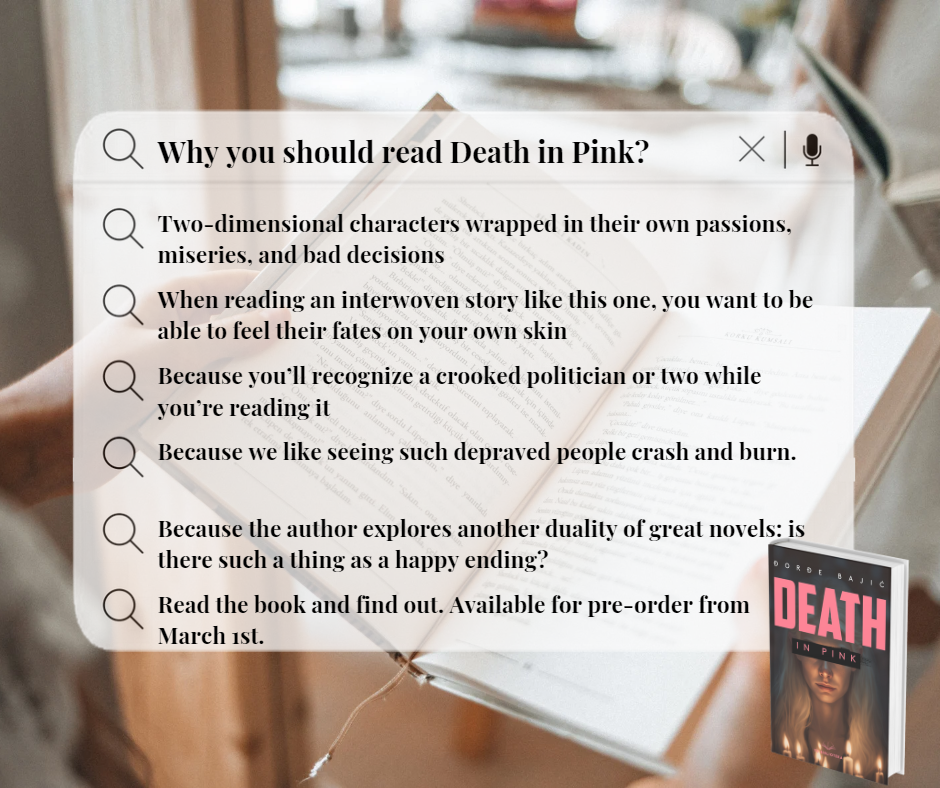Death in Pink: A Novel of Passion

“Unravel the lies, and you will find the truth.”
After the success of “My Love, Nikola Tesla,” the first book written by a Serbian author that was published by our very own Yu Biblioteka, comes the second translation and publication of a Serbian masterpiece. “Death in Pink” explores an unusual murder and the equally unusual victim and suspects, and reflects the status quo of modern society in Serbia.
My first clue that this book was something worth reading was the fact that I had waited for more than three weeks for the title to become available in my local library. (To be fair, the reason behind this might have been slow readers.) The fact that it was going to be translated and published in English only two years after its Serbian release was my second clue.
The truth is, we need more Serbian authors published in English and other international languages. It’s not fair to keep all the treasures of modern Serbian literature all to ourselves (and our Serbian-speaking neighbors). Novels like this one should be presented to wider audiences, and Death in Pink deserves to pass on the torch and enlighten the path of Serbian literature to the stardom of world-class prose.
In the interview with the author, Đorđe Bajić describes his fourth child as an “urban, contemporary, largely realistic story” with made-up characters and crimes but a very realistic depiction of present-day Belgrade. To peek behind the curtain of the great Wizard of Oz, give the interview with Đorđe a read.
Let’s see what makes Death in Pink a masterpiece of the crime genre.
The hows and the whys
I personally love knowing how something was made. I love learning about the process of writing a book, cutting down paragraphs, killing darlings, editing, deleting, and paraphrasing. But most of all, I love learning about how a particular story came to be.

That seems to be a popular question to ask any artist. When they ask Stephen King how on earth he came up with Misery or James Cameron how the idea for Avatar came about. When asked the same question, Đorđe Bajić said that he envisioned this novel as an introductory tale of police inspector Nikola Liman, which hopefully means there will be more to come.
As an amateur scribbler, I can conclude that the main figure was Inspector Liman and that everything else was built around him. I can already imagine Đorđe going about his day and never stop thinking about this man who popped into his head one day and refused to leave. Eventually, the man received a name, a job description, basic character traits, and an entire background story. Soon, Đorđe knew all about this man: his fears, his weaknesses, his greatest love, his greatest vice, what kind of a cop he was, what he liked for breakfast, the manner in which he talked to his supervisors and to those he disliked.
Đorđe might have then been inspired by some local murder cases, or something gruesome or equally odd he read in the news, and in a split second, everything clicked. Nikola Liman has a case he needs to break, suspects to interrogate, and a dangerous man to catch, all the while fighting his inner demons and trying to patch things up with his loved one.
Boom. That’s how you come up with a great story with layered characters.
Meet Nikola Liman, the antihero
The golden rule of fiction writing is to make your characters suffer. To plunge them into the fire and watch them squirm their way out of it. The stories of characters who suffer and endure it all are great stories with strong protagonists, or antagonists, and exceptional character arcs.
In Death in Pink, we follow Nikola and the hottest case for the Belgrade police since sliced bread. A beautiful woman was found dead in her house, a house paid for by her mobster ex-husband, the most powerful shady figure in the country. Her friends are in shock and despair, but the victim’s current boyfriend has mysteriously disappeared. As the case unravels, more secrets swim to the surface, and Nikola realizes that nothing is what it seems.

This great story is driven by the conflict of our protagonist, the typical Byronic hero. Those well-versed in literary techniques will recognize the classic antihero traits in Nikola Liman—intelligent, educated, and ingenious, yet cynical and self-destructive. The author gave him broad shoulders, piercing eyes, and a magnetic attraction that seems to attract only trouble for our antihero.
But don’t worry, an antihero does not equal bad. If anything, similarly to every other Byronic hero in literature (think Wuthering Heights and Heathcliff), Đorđe Bajić made her protagonist to be bad only for himself. A terrific investigator, a handsome man, and an unfaithful drunkard.
Barbie girl in a twisted world
What Death in Pink brilliantly achieves is the social commentary adorned in subtlety and perception. The author says that society should be criticized, and, boy, there’s no ground more fruitful for that than the Serbian one.
In the spotlight of the murder investigation is a beautiful doll murdered inside her pink dollhouse. A woman obsessed with aesthetics and perfection. A woman with a blurry age—is she 25, is she 45, who knows. A woman who desperately wanted to be liked, to make magazine covers, to be relevant. The fictional character of Ivana Ružić embodies every woman who changed her appearance in order to be accepted. The fact that the public was horrified when she was killed makes for an even more realistic commentary on the state of mind we keep denying yet swim comfortably in—it’s always a greater tragedy when a thing of beauty is damaged. Isn’t it sad to see a pretty woman dead? What kind of monster would dare to end such a beautiful life?
The victim’s obsession with being famous, liked, and perfect was finally realized in her death. The tabloids, the infamous “yellow press,” venerated her innocence and perfection, and it was only after Ivana Ružić had died that she finally received all the attention she wanted.
Should society be criticized? Absolutely. The twisted, corrupted society like in Serbia has no choice but to be criticized. It’s impossible to write a realistic novel like this one and avoid this topic altogether because, without the corrupted factor, there would be no crime and no antiheroes.
Out of all cities in the world, the author chose his hometown, the hot spot of crime. Why Belgrade? Đorđe Bajić explains that Belgrade carries this discernable duality: a beautiful place with deep passion that’s rotting from the inside. At the same time, the Serbian capital is under construction and in decay, with glimpses of an optimistic future frequently shaded by the root of all evil that eats the city one neighborhood at a time.
No other setting could be more desirable for a murder mystery.
Why you should read it

In case all of the above wasn’t enough to convince you to give this gem of the modern crime genre a go, let’s try something simpler.
Because you get two-dimensional characters wrapped in their own passions, miseries, and bad decisions. When reading an interwoven story like this one, you want to be able to feel their fates on your own skin, to sympathize with them or hate them with all you’ve got. Nikola Liman’s rocky marriage makes us want to be on his side as he seeks repentance and forgiveness.
Because you’ll recognize a crooked politician or two while you’re reading it. These corrupted people working in jobs we depend on for protection and justice turn out to be deprived of any sense of justice. Most of them are driven by blind ambition, backed by the murky businesses of mobsters turned entrepreneurs.
Because we like seeing such depraved people crash and burn.
Because the author explores another duality of great novels: is there such a thing as a happy ending?
Read the book and find out. Available for pre-order from March 1st.
Truly yours,
Vanja
